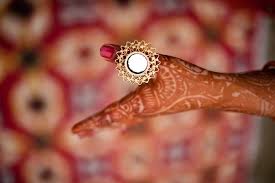There is a small child across the street who jingles. Which, I assure you, is not another one of her quirky qualities (I tried to start a friendly conversation with her once. She adamantly held her tongue. Literally, she held her tongue between her point finger and thumb and refused to speak). I can hear the tinkling of her anklets from my second-floor apartment when I leave the window open as she runs between the hair salon her mother runs and the mobile recharge store her father runs next door.
…
A couple of months ago, I went out to buy myself some jewelry at Commercial Street. I don’t know if the salesmen were trying to bamboozle what they saw as a somewhat naïve foreigner, but they refused to sell toe rings in anything but pairs. Apparently it was bad luck. So I ended up buying myself a pair of braided silver toe rings.
…
“Akka, akka” a young student points at my toes, “Akka, are you married?”
“No.”
Apparently, in the Hindu tradition, silver toe rings on both feet symbolize a married woman.
So, finding that it was stylistically acceptable to just rock one toe ring, I took to this instead. No more marriage questions, I’d hoped. And yet, at the supermarket,“Akka!” I hear a voice down at my feet. An old sari-clad woman restocking the shelves points at my foot and then looks up concernedly. She doesn’t quite understand why only one of my toes is ringed.
Damn it, you just can’t win. I assure her it’s not a problem, I try to communicate through imaginative gesticulations that I’m neither married nor widowed nor something else…
…
Anklets and toe rings, bangles, bindis, flowers ornamenting hair. A visual richness blossoms from the kaleidoscope of multi-colored accessories complementing the already cheerful hues of sari-clad women. It’s a sight I’ll be sure to miss when I leave India. Although I think the younger generation appreciates a more minimalistic style, one can easily find all these accessories adorning just one individual of the older generation without a modicum of gaudiness.
Examining the solah shringar, the sixteen adornments that make up the ‘beautification process’ that a Hindu bride should observe on her wedding day, includes the many types of jewelry worn thereafter on a regular basis, and also gives compelling explanations as to why they are worn. I love the layers of meaning I find here, even if they are often lost in modernity and distilled to simply, because it looks nice.

So why 16 adornments? Because historically it was believed that the 16 phases of the moon directly affected a woman’s menstrual cycle, and that any negative effects of these phases could be nullified by the solah shringar, which would be favorable for conception.
According to Hindu mythology, the solah shringar is a celebration of the beauty of the woman. Nowadays though, a woman may not wear all of the 16 adornments, especially those who appreciate a more minimalistic approach to fashion as I mentioned before. Now, what exactly these 16 adornments are change depending on what source you read. These were the ones I saw recurring across various sources.
Many of these adornments worn by women are thought to bring luck, ward off evil spirits, and maintain health (and it was oft mentioned that if they broke or were lost, it was a bad omen for the husband/marriage).
 1. Anklets and toe rings
1. Anklets and toe rings
Toe rings are usually worn on the second toe of each foot and are a symbol of a married woman. They are usually worn in pairs to symbolize a woman’s status as a sister and wife; if her brother or husband dies, one set is removed. If her husband were to pass, then her brother would offer her protection. Toe rings been around since Ramayana times, where it was mentioned that Sita, when abducted by Ravana, left behind her toe ring(s) so that lord Rama could find her.
You’ll probably never find a gold toe ring because gold is considered a metal of the gods (especially Lakshmi) and its inappropriate to wear below the waist.
From a reflexology point of view, it is believed that putting pressure on the second toe helps regulate the menstrual cycle (connected to conception) and the rings are worn on both feet to balance the energies being conducted from the earth to the body through the rings.
The wedding payal (anklets) usually have bells so one can hear the bride coming.

2. Wedding dress
The dress can be a sari, lehenga, salwar kameez, etc. and is often a bright color (red and maroon are seen as auspicious) embroidered with gold thread.
 3. Hairstyle (Keshapasharachana)
3. Hairstyle (Keshapasharachana)
Keshapasharachana is the way the hair is worn for the wedding. Kesh means hair, pash means flock, and rachna means arrangement. I’ve been wondering for a long time what the significance of the braid (or the plait as it’s called here) is, and it seems like it symbolizes various trinities: the rivers of Ganga (Ganges), Yamuna, and Saraswati; the trinity of Brahma, Vishnu, and Shiva; and another theory relating to marriage is the bride’s father’s house, her in-law’s house, and herself (who will unite these entities).
4. Flowers
The bride’s hair is adorned with flowers and accessories (usually the fragrant jasmine flower).
 5. Mangtikka
5. Mangtikka
Mangtikka is an accessory worn on the central parting of the hair on the forehead. The center of the forehead, often where “the mind’s eye” is depicted, is believed to house the ajna chakra which is home to intellect and intuition. This chakra also stands for preservation and is shown with two white petals and sometimes with the deity Ardhanarishvara, a hermaphrodite form of Shiva-Shakti, therefore symbolizing the union at many levels of man and woman.
 6. Vermillion (Sindoor)
6. Vermillion (Sindoor)
This is applied on the central parting of the hair, and it is sometimes mandated that a married woman wear it at all times. The groom puts sindoor on his wife’s hair parting for the first time during the wedding rituals (or perhaps his mother will, welcoming the bride to the family). It is believed to symbolize the energy of Parvati or Sati (the most devoted wife of Lord Shiva), which wards away bad spirits and safeguards her husband.
7. Bindi
The bindi replaces the mangtikka as an adornment worn on the forehead (remember: agna chakra) after the wedding. In the present day, it is worn by women of many religious dispositions and also as a purely decorative item. There are many different styles of bindi. My favorite style I’ve seen so far is worn by the Head of Academics at Parikrma where I work, and it looks like a small, black lightning bolt. Bindi comes from the Sanskrit word “bindu” meaning “point” or “drop.”
8. Kohl
Kohl is used to line the inner and outer rim of the bride’s eyelids, accentuating and highlighting her eyes. It was often homemade.

9. Nose ring
The practice of nose piercing and nose rings (nath) came about as part of cultural exchange when the Mughals spread their reach through India, as Muslim brides were mandated to wear them. It began appearing in Rajput paintings around the 15th or 16th century. In fact, ‘nath’ in Hindi includes the meanings of husband or master. In the past, single or widowed women could not wear the nath, but nowadays it’s a common sight on anyone here in India.
10. Earrings
Karn phool (earrings) is a Sanskrit word meaning flower of the ear. Earrings were often worn as visible indicators of a woman’s wealth, and the resulting elongated ear lobes from the heavy jewelry were also considered a sign of both wealth and beauty.
 11. Necklaces and Mangal Sutra (“Holy Thread”)
11. Necklaces and Mangal Sutra (“Holy Thread”)
Necklaces worn at weddings are mostly gold, and sometimes embellished with precious stones and elaborate designs. There is a specific kind of necklace, often with gold and black beads, that the groom puts on the bride called the Mangal Sutra. During the ceremony, there are 3 knots that are tied into the necklace, sometimes by the groom or his sisters. The knots are meant to signify obedience to the husband, to her in-laws, and finally to God.However, the Mangal Sutra is not an integral part of the wedding ceremony across India, and there are also many regional variations in the design of the necklace and the knot-tying tradition.
Because necklaces are worn near the heart, they were thought to affect emotions. From ancient times, protective pendants and necklaces were worn to bring good luck and avert the evil eye.
 12. Henna (Mehendi)
12. Henna (Mehendi)
The bride’s hands and feet are decorated with intricate designs and patterns using mehendi paste. Once the mehendi is dried and washed off, it leaves behind an orange-red color, which symbolizes many things such as fertility, strength, and emotional and sexual connection between the bride and groom. One popular belief is that the darker the color of mehendi, the deeper the love between the would-be couple (aww).
13. Bangles and Armbands
Armbands are worn on the upper arm of the bride, and are usually made of gold with precious stones encrusted. The bangles, which hang by the wrists, are made either of gold, glass, metal, ivory, or lac in varying colors such as red, green, white, or gold depending on custom and tradition.
 14. Thumb rings
14. Thumb rings
Traditionally, many brides wore a dupatta (a cape/veil which would also cover her face) as part of her wedding attire. It would hinder her from seeing her partner, so the thumb ring was often embedded with small mirrors so she could catch a glimpse of her soon-to-be spouse.
15. Kamarband
Kamarband is an ornament tied around the waist. It is a beautiful belt, usually made of gold with precious gems, and aids in holding the sari in place (it also does a marvelous job in accentuating the waist of the bride 😉 ).

16. Fragrance
Ittar is an all-natural perfume oil made from botanical sources, which keeps the bridge smelling fragrant throughout the long ceremony. Ittar is highly concentrated, devoid of alcohol and chemicals, and have been used in the East for thousands of years.



































 1. Anklets and toe rings
1. Anklets and toe rings 
 3. Hairstyle (Keshapasharachana)
3. Hairstyle (Keshapasharachana) 5. Mangtikka
5. Mangtikka 6. Vermillion (Sindoor)
6. Vermillion (Sindoor)

 12. Henna (Mehendi)
12. Henna (Mehendi)












